Even if cacti come from desert regions, there are some varieties that survive our winters. We present ten hardy cacti.

Cacti are particularly popular as ornamental plants: Undemanding and robust, the plants are usually also perfect for beginners and still provide decorative eye-catchers in the house. But all too often, the beautiful exotic species are kept exclusively in the apartment, because only a few gardeners know that cacti can also be planted wonderfully in the garden. In fact there are many cactus species, which can stand outside all year round even in our latitudes and endure even snow and freezing cold. German gardeners can also enjoy the decorative plants in the garden and make their bed an interesting eye-catcher with the help of cacti. We will tell you here which species are best suited for this and how they are best cared for in winter.
That cacti do not survive the winter in the bed is a fairy tale that persists. In fact, it all comes down to picking the right species—especially cacti, which are in Mountain regions are native, are also adapted to icy cold and can in our latitudes easily survive. Nevertheless, you should pay attention to a permeable, dry soil and, if necessary, rain protection.
contents
- 10. Escobaria vivipara
- 9. Echinocereus coccineus
- 8. Opuntia fragilis
- 7. Echinocereus triglochidiatus
- 6. Opuntia macrocentra
- 5. Opuntia basilaris
- 4. Opuntia polyacantha
- 3. Cylindropuntia echinocarpa
- 2. Opuntia phaeacantha
- 1. Cylindropuntia imbricata
10. Escobaria vivipara
Small but mighty - with a height of only seven centimetres Escobaria vivipara one of the smaller representatives of the cactus family and is easily underestimated. In fact, the plant is particularly robust, with rain protection it can easily withstand temperatures down to -15 °C outdoors. If it then shows its impressive, bright pink flowers, which reach a diameter of five centimetres, in summer, the small exotic even steals the appearance of the large cacti.

9. Echinocereus coccineus
It is easy to care for and also suitable for inexperienced cactus gardeners Echinocereus coccineus. The plant can withstand temperatures down to -20 °C, but this requires a dry location and, if necessary, rain protection. If you can offer this to the plant, please Echinocereus coccineus its owner with its unique beauty: the blossoms of the exotic radiate in one conspicuous orange or red and also the spherical, thorny fruits carry the bright hue.

8. Opuntia fragilis
The homeland of the Opuntia fragilis – this means that the plant is officially considered the most northerly widespread type of cactus. So it's no wonder that it survived the German winter without any problems. The dainty cactus can easily cope with temperatures down to -20 °C, but it also prefers rain protection. Overall, it is the Opuntia fragilis a very small cactus that reaches a height of five to ten centimeters. On the other hand, the exotic plant grows in mats and is therefore ideal as an underplanting for large cacti and, thanks to its beautiful flowers, also looks great.
7. Echinocereus triglochidiatus
With its funnel-shaped, bright red flowers, which have a light throat inside, the Echinocereus triglochidiatus probably one of the most beautiful cacti that can be found in German gardens. With its cushion-like growth, the plant is a real eye-catcher even without flowers, which is definitely something to be proud of. Additionally applies Echinocereus triglochidiatus as particularly easy to care for and can withstand temperatures down to -12 °C without special weather protection. If you also equip the cactus plant with rain protection, it should even be hardy down to -25 °C.

6. Opuntia macrocentra
The Opuntia macrocentra. Instead of the typical green robe, many specimens show bluish or even violet shoots and thus provide an extravagant eye-catcher in the cactus bed. The yellow-red flowers and the purple-colored fruits are not to be scoffed at either. Luckily, despite its eccentric looks, this particular eye-catcher isn't particularly demanding when it comes to grooming. Depending on the variety and cultivation, the cacti can withstand temperatures down to -20 °C with rain protection.

5. Opuntia basilaris
With its blue-green color and slight red tint along the areoles, it is Opuntia basilaris a true beauty that no gardener should miss. But one thing in particular makes the cactus extremely interesting for the garden: in contrast to most other cactus plants, it bears fruit Opuntia basilaris normally no thorns and thus does not cause unwanted injuries. In addition, the plant shines with a good winter hardiness of down to -20 °C if you can offer it a permeable location with rain protection.

4. Opuntia polyacantha
Hardly any other cactus is as suitable for cultivation in the German garden as this Opuntia polyacantha. The perennial plant tolerates temperatures down to -20 °C and is considered to be significantly more tolerant of moisture than many other species. However, rain protection for the plant is still recommended, especially in winter, as this increases its winter hardiness. Overall, the plant species is divided into five varieties, all of which shine with a growth of up to 15 centimeters and a large number of needle-like thorns. Particularly Opuntia polyacantha var. trichophora is worth a second look - this one has thin, almost hair-like thorns.
3. Cylindropuntia echinocarpa
With its richly branched, shrub-like growth and its height of half a meter to two meters, the Cylindropuntia echinocarpa integrate perfectly into every cactus bed. The green-grey plant stands out thanks to its striking yellow glochids and white thorns and turns out to be a real feast for the eyes. The eye-catching exotic is also a real ornament in Germany - easy to care for and robust, it can withstand temperatures down to -25 °C if you can offer it rain protection.

2. Opuntia phaeacantha
so far is Opuntia phaeacantha, also called black-brown thorn prickly pear cactus, rarely found in Germany. It's a pity really, because the plant actually has everything a good cactus needs: robust and easy to care for, it is a true survivor, but also scores with a rich abundance of flowers and edible ones fruits. To grow them in the garden, all you really have to do is choose the right location. This should be sunny and equipped with permeable but nutritious soil. If these basic conditions are correct, the Opuntia phaeacantha even withstand temperatures down to -20 °C - and all without rain protection.
1. Cylindropuntia imbricata
Anyone looking for a hardy cactus is with us Cylindropuntia imbricata properly advised. The cactus can withstand temperatures of up to -30 °C in sheltered places. If the cactus is fully exposed to the weather, it can endure temperatures down to -20 °C. Originally originated Cylindropuntia imbricata, also known as perennial prickly pear, from the desert-like mountain regions of the USA. Due to its extremely robust nature, the cactus plant has also spread to Europe, where it can be found in parts of France, Spain and Switzerland. In the German bed, the exotic captivates with a stately height of up to four meters and with its magenta-colored flowers, which turn into edible fruits from July. Additionally applies Cylindropuntia imbricata extremely easy to care for, the only thing the plant does not tolerate is waterlogging.
If you are now further interested in cacti and succulents, you will find ours here 5 best care tips for the exotics.




